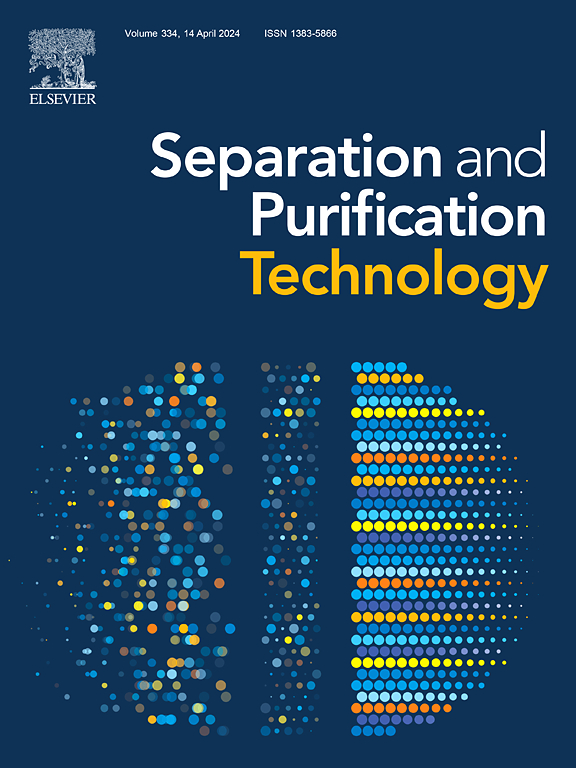Readily accessible metal-hybrid organic linker gels for high-efficient recyclable iodine capture
IF 9
1区 工程技术
Q1 ENGINEERING, CHEMICAL
引用次数: 0
Abstract
Efficient capture of iodine concerns nuclear waste management. Crystalline metal–organic frameworks (MOF) have been demonstrated to be useful in iodine adsorption, but remain a great challenge due to their complex synthesis conditions and poor processibility. In this study, we synthesized a novel metal-hybrid organic linker gel composed of Zr-carboxylate-tannate networks via competitive coordination-driven gelation. By virtue of supramolecular nuclei aggregation, the gels exhibited a hierarchical micro-mesoporous structure to accommodate iodine molecules. Moreover, the abundant phenolic OH groups of the tannate linker provided adsorption sites for iodine, imparting gels high binding energy with iodine. The gels demonstrated an exceptional iodine vapor adsorption capacity (311 wt%), surpassing many crystalline MOFs. The gels manifested impressively recyclable adsorption performances. The iodine capacity was retained over 95% during three consecutive adsorption–desorption cycles. Interestingly, the metal-hybrid linker coordination and gelation enabled the in-situ formation of monolithic structures, which displayed satisfactory iodine capacity. There is nearly no capacity loss compared to the powder form, indicating that gelation offers a promising in-situ adsorbent shaping manner. This study unlocks the great potential of non-crystalline, easily accessible metal–organic gels as high-performance adsorbents for radionuclide sequestration.


易于获得的金属杂化有机连接凝胶,用于高效可回收的碘捕获
有效捕获碘涉及核废料管理。晶体金属-有机骨架(MOF)在碘吸附中已被证明是有用的,但由于其合成条件复杂且可加工性差,仍然是一个很大的挑战。在这项研究中,我们通过竞争配位驱动凝胶合成了一种由zr -羧酸-单宁酸网络组成的新型金属杂化有机连接凝胶。通过超分子核聚集,凝胶呈现出层次微介孔结构以容纳碘分子。此外,单宁酸连接剂中丰富的酚羟基为碘提供了吸附位点,使凝胶与碘具有较高的结合能。凝胶表现出优异的碘蒸气吸附能力(311 wt%),超过许多晶体mof。凝胶表现出令人印象深刻的可回收吸附性能。在连续三次吸附-解吸循环中,碘容量保持在95%以上。有趣的是,金属杂化连接剂的配位和胶凝使原位形成了整体结构,表现出令人满意的碘容量。与粉末形式相比,凝胶几乎没有容量损失,这表明凝胶是一种很有前途的原位吸附剂成型方式。这项研究揭示了非晶态、易于获取的金属有机凝胶作为放射性核素隔离的高性能吸附剂的巨大潜力。
本文章由计算机程序翻译,如有差异,请以英文原文为准。
求助全文
约1分钟内获得全文
求助全文
来源期刊

Separation and Purification Technology
工程技术-工程:化工
CiteScore
14.00
自引率
12.80%
发文量
2347
审稿时长
43 days
期刊介绍:
Separation and Purification Technology is a premier journal committed to sharing innovative methods for separation and purification in chemical and environmental engineering, encompassing both homogeneous solutions and heterogeneous mixtures. Our scope includes the separation and/or purification of liquids, vapors, and gases, as well as carbon capture and separation techniques. However, it's important to note that methods solely intended for analytical purposes are not within the scope of the journal. Additionally, disciplines such as soil science, polymer science, and metallurgy fall outside the purview of Separation and Purification Technology. Join us in advancing the field of separation and purification methods for sustainable solutions in chemical and environmental engineering.
 求助内容:
求助内容: 应助结果提醒方式:
应助结果提醒方式:


